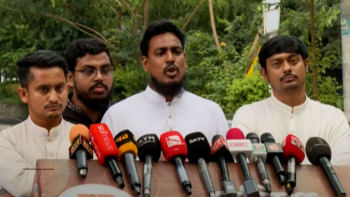Stop the decline, please
After national team, disaster has struck our football in club level too.
Not so long ago, a mediocre club from Dhaka would go to Nepal and win a club tournament comfortably.
In the 80s, scoring at will against a Maldives club was as easy as putting eight goals past their national team. Those days are over now.
After the national team were overwhelmed by lower-ranked teams like Afghanistan and Bhutan, Abahani's humiliating defeat to Nepal Police Club in Sunday's AFC President's Cup match in Kuala Lumpur proves that.
Shocking? No. There had been no competitive football at the top level since August 1, 2007 when the B. League had concluded. The writing was on the wall for long. We just ignored it while Bangladesh's world ranking slid down to as low as 183.
Now Bangladesh don't even get to play in the 2011 Asian Cup pre-qualifiers, which they did December 2005 and went on to compete in the qualifiers after a 0-0 home draw with Pakistan and a 1-0 away victory. There goes the chance of playing at least six international matches, three at home.
It all happened because Bangladesh were relegated to the third-tier (the least developed) of Asian team due to poor performance.
It is not difficult to trace out where the rot begun, how did it continue or who are responsible for this.
A visiting Sri Lankan introduced football to the Maldives in the 1970s, when Bangladesh had already had their affiliation with FIFA and AFC.
The game is now played by just over 5,000 of the Indian Ocean island chain's below 3-lakh population. Their first division comprises with just six clubs and when they played in the regional SAF Games, Maldives immediately became the wooden spoon of their group, losing 5-0 to Bangladesh in 1984 and 8-0 in the following year.
In 1986, Maldives became affiliated with AFC and FIFA and continued improving, reaching the final of the inaugural SAFF Championship in 1997.
Holding Asian football powerhouse and 2002 World Cup semifinalists South Korea to a goalless draw in the 2006 World Cup qualifiers might have had put the entire nation to a standstill but their triumph in the fifth SAFF Championship earlier this month after beating India in the final stands as the best result in the brief history of Maldives football.
It proves how planning and dedication can lead even a small nation to glory.
Nepal were also on the decline after winning two SAF Games soccer titles but now seem to take the right road through club football.
Their national team have yet to re-establish their status in the region but it would not take them long to cash on a club's success. Nepal Police Club finished runners-up in last year's President's Cup and began exactly where they had left off.
Why talk about Nepal's club team? A club from Bangladesh should have not played in the President's Cup at all.
The AFC has demoted Bangladeshi clubs to the third-tier competition from the more prestigious AFC Cup after the Bangladesh Football Federation (BFF) failed to send any team to last year's competition simply because there was no league in 2006.
After scrappily organising the B. League -- the inaugural professional league -- in 2007, Bangladesh got the nod to send a club only to the President's Cup that is not even a home-and-away competition like the AFC Champions League or the AFC Cup.
Those officials who are responsible for this, then refused to host the President's Cup group stage in Dhaka, denying Abahani to take advantage of being the home side. The reason? The tournament schedule clashed with the campaigning for the BFF election.
Lingering in the past won't bring back anything but what the guardian of the country's football needs is to take a modern approach toward the development of the clubs and national team, let alone fixing long-terms plans to get into the grassroots.
Just bringing a foreign coach for the national team or continuing playing the so-called professional league with non-existing club structure will not suffice. Players need to be prepared by the clubs so that they can join the national team anytime of the year with full fitness. Talking about fitness, do any of the professional clubs have a full-fledged gymnasium?
We have walked back by showing the doors to men like George Kottan and Diego Cruciani and Syed Nayeemuddin to give responsibility to local guy Abu Yusuf, who was asked to shape an unfit squad in two months before the SAFF Championship without the help of a trainer.
Having had no chance to get updated with the modern game and its technique, our local coaches still have the mindset of the medieval age.
We have to decide whether we want to stay where we are or walk forward or just keep flattering to deceive.

 For all latest news, follow The Daily Star's Google News channel.
For all latest news, follow The Daily Star's Google News channel. 



Comments